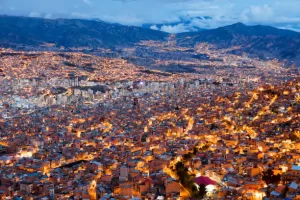La Paz, Bolivia, is a city like no other, perched high in the Andes at an elevation of 3,650 meters (11,975 feet). As the world’s highest administrative capital, it offers breathtaking views, rich cultural experiences, and an unforgettable mix of tradition and modernity. Whether you’re seeking adventure, history, or culinary delights, La Paz has it all.
Essential Information
- Location: Western Bolivia, in the Andes Mountains.
- Altitude: 3,650 meters (11,975 feet) above sea level.
- Currency: Boliviano (BOB).
- Language: Spanish, with Aymara and Quechua widely spoken.
- Best Time to Visit: May to October (dry season) for clear skies and ideal trekking conditions.
Interesting Facts
- Cable Car System: La Paz boasts the largest urban cable car network in the world, offering stunning views and efficient transport.
- Moon Valley: A surreal landscape just outside the city, created by centuries of erosion.
- Unique Markets: The Witches’ Market (Mercado de las Brujas) sells mystical items like talismans and potions.
- Historic Altitude: The city’s high elevation often requires visitors to acclimate to avoid altitude sickness.
- Dynamic Geography: La Paz is nestled in a deep valley, surrounded by snow-capped peaks like Illimani, providing dramatic scenery.
How to Get There
By Air
- El Alto International Airport (LPB) is the main gateway, with flights from major cities in South America and beyond.
With Bus
- Comfortable long-distance buses connect La Paz with cities like Cochabamba, Sucre, and Puno (Peru).
- The Cementerio Bus Terminal serves as the main hub.
By Train
- The city isn’t directly served by rail, but nearby towns like Oruro connect via the train system for exploring other regions.
Best Things to Do
- Explore the Witches’ Market: Discover traditional remedies, charms, and mystical items unique to Bolivian culture.
- Ride the Teleférico: Enjoy panoramic views while traveling between neighborhoods on the cable car system.
- Visit Plaza Murillo: The historic center, home to the Presidential Palace and La Paz Cathedral.
- Hike in Moon Valley: Wander through alien-like rock formations on scenic trails.
- Death Road Biking: For thrill-seekers, cycle down the world-famous Yungas Road.
- Cholita Wrestling: Witness women in traditional attire competing in lively wrestling matches.
- Street Art Tours: Explore the city’s vibrant murals and graffiti, reflecting local stories and cultures.
Best Accommodation Options
Luxury
- Casa Grande Hotel: A modern hotel with stunning views, a spa, and fine dining.
- Atix Hotel: A boutique property showcasing Bolivian art and architecture.
Mid-Range
- Hotel Rosario: A charming colonial-style hotel with comfortable rooms and great service.
- La Casona Boutique Hotel: Offers a blend of historical charm and modern amenities.
Budget
- Wild Rover Hostel: A popular spot among backpackers with a lively atmosphere.
- Loki Hostel: Known for its social vibe and stunning views over the city.
Cultural and Modern Attractions
- National Museum of Ethnography and Folklore: Learn about Bolivia’s rich cultural history.
- San Francisco Church: A colonial masterpiece with an ornate facade and fascinating museum.
- El Alto Market: One of the largest open-air markets in South America, bustling with activity.
- Calle Jaén: A well-preserved colonial street lined with museums and quaint shops.
Dining and Nightlife
Dining
- Gustu: A fine-dining restaurant focused on Bolivian ingredients and flavors.
- Ali Pacha: A plant-based restaurant offering innovative dishes.
- Mercado Lanza: Enjoy authentic Bolivian street food like salteñas and api with pasteles.
Nightlife
- The English Pub: A lively spot for drinks and mingling with locals and travelers.
- Diesel Nacional: A quirky bar with industrial decor and creative cocktails.
- Malegria: Known for its vibrant atmosphere and live music.
Day Trips
- Tiwanaku Ruins: Explore ancient pre-Columbian ruins located about 70 km from La Paz.
- Lake Titicaca and Isla del Sol: Visit one of the highest navigable lakes in the world and its sacred islands.
- Chacaltaya Mountain and Huayna Potosí: Great for adventure seekers looking to trek or enjoy mountain views.
- Yungas Cloud Forest: Experience a lush contrast to the high-altitude landscape of La Paz.
Getting Around
- Cable Cars: The most scenic and efficient way to travel across La Paz.
- Minibuses: A common and affordable mode of local transport, though routes can be confusing.
- Taxis: Widely available and inexpensive, but negotiate fares in advance.
- Walking: Many attractions are within walking distance in central La Paz, though the steep streets can be challenging.
Practical Tips
- Altitude Sickness: Take it slow on arrival, stay hydrated, and consider coca tea to help with acclimatization.
- Local Currency: Carry small denominations of Bolivianos, as larger bills may be hard to break.
- Safety: Stay alert in crowded areas, especially markets, to avoid pickpocketing.
- Weather: Pack layers; the high-altitude climate can vary greatly throughout the day.
- Cultural Etiquette: Always ask for permission before photographing locals, especially in traditional attire.
Conclusion
La Paz is a city of contrasts, where ancient traditions meet modern innovation, and breathtaking landscapes blend with vibrant culture. Whether you’re exploring bustling markets, marveling at natural wonders, or savoring local flavors, La Paz offers a truly unique experience. A trip to this Bolivian gem promises adventure, culture, and unforgettable memories.

